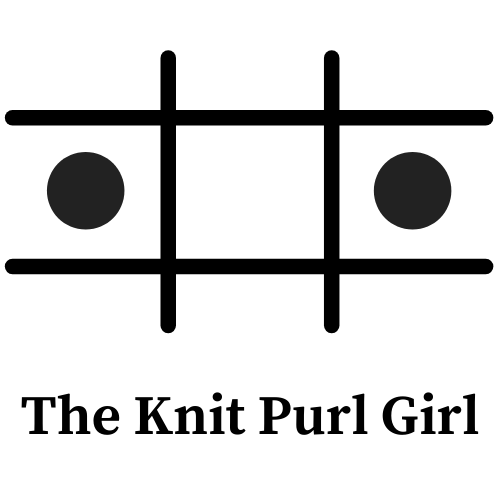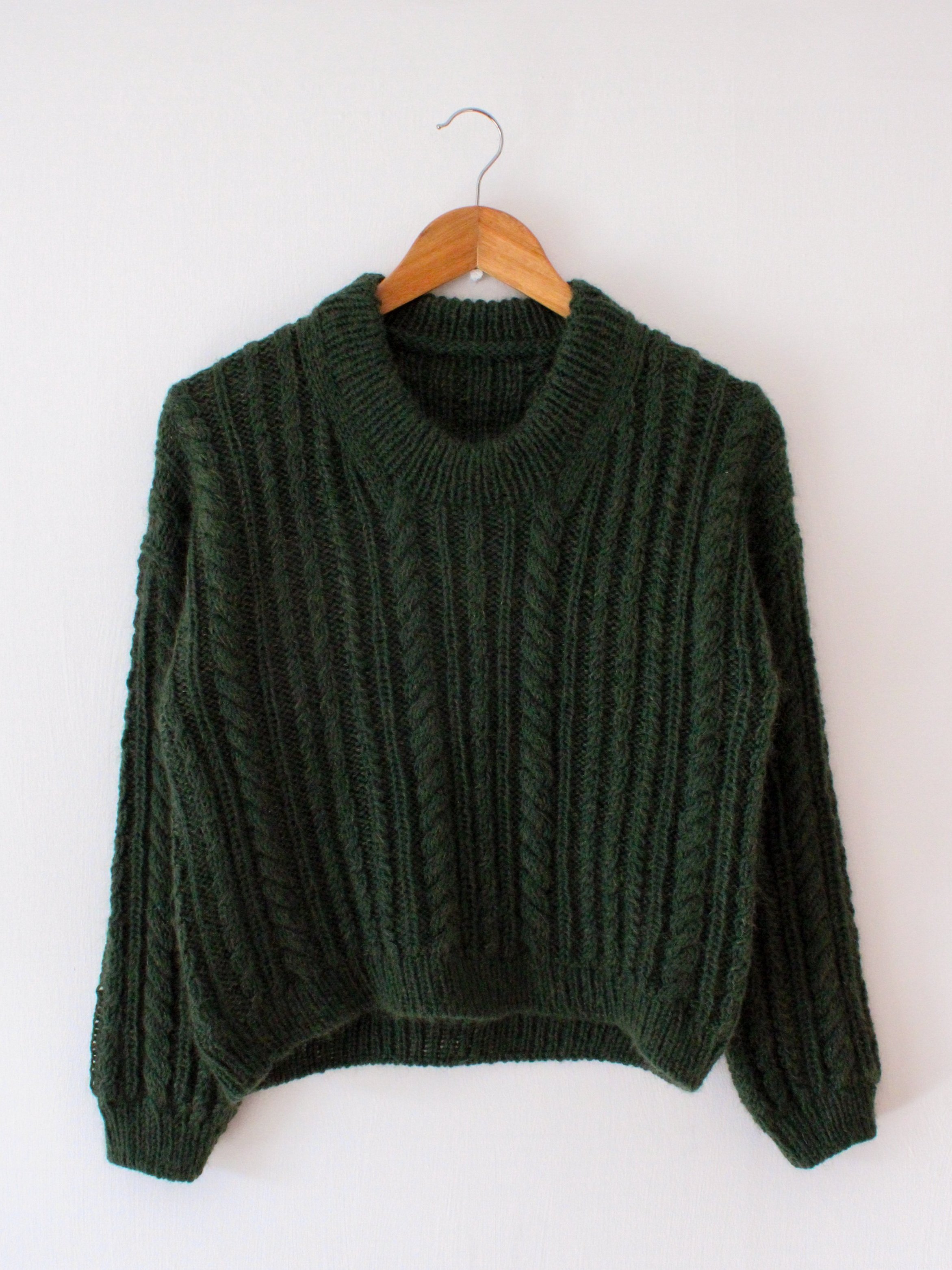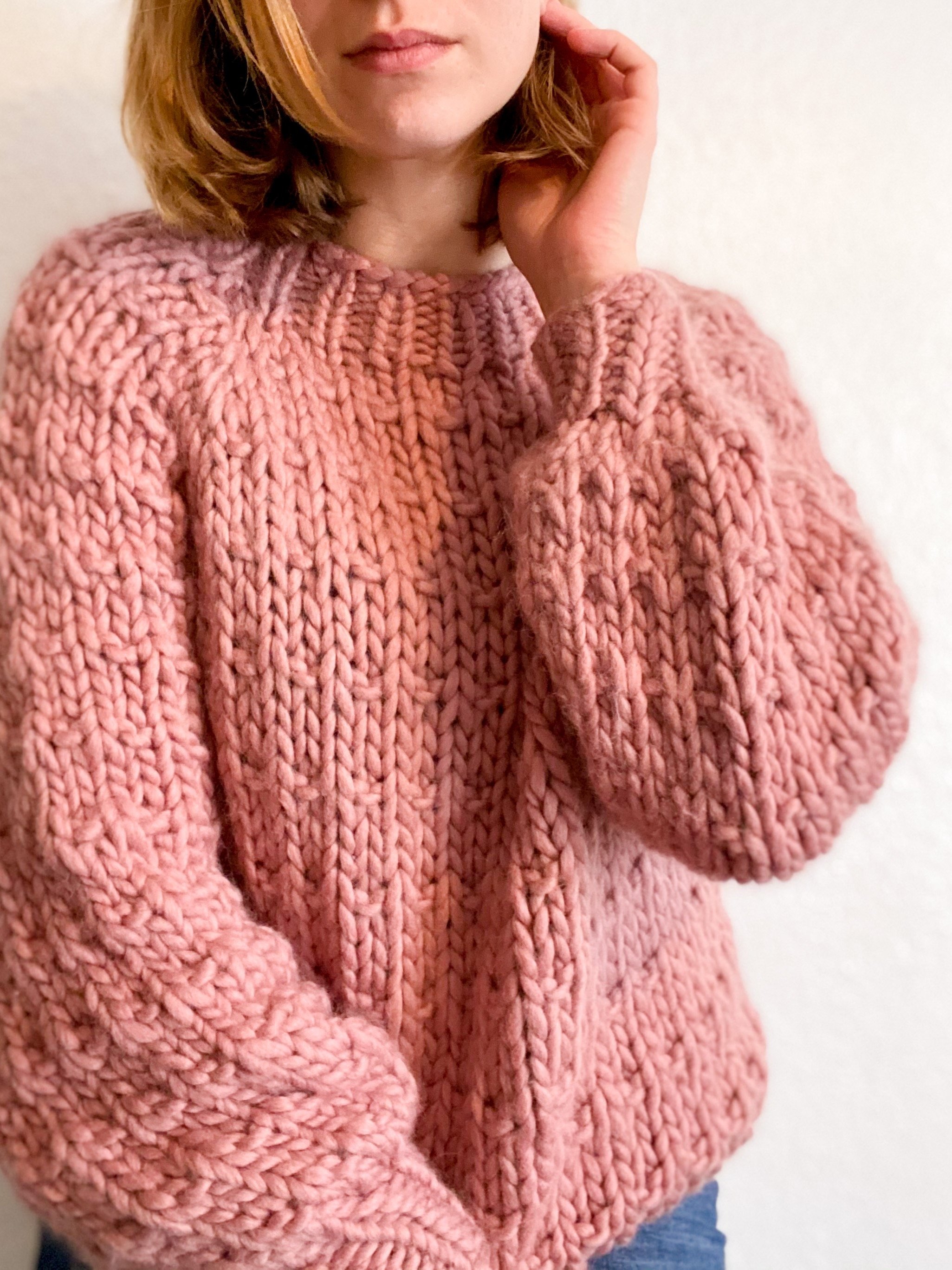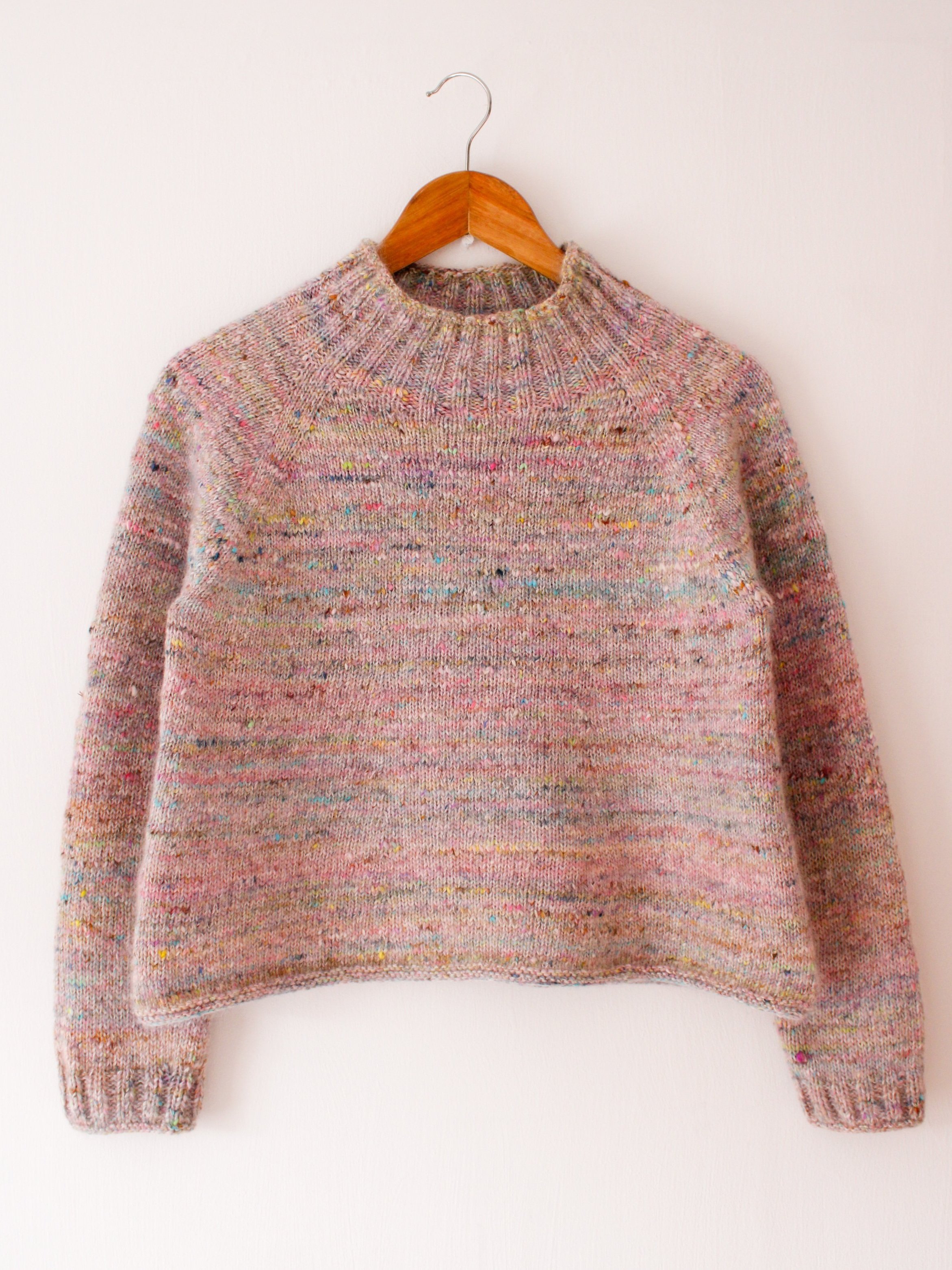Seaview Sweater
The Seaview Sweater is an oversized drop shoulder sweater with an all-over cable motif. The sweater is worked top down, both flat and in the round. The fit is very relaxed and slouchy, and the sleeves have a slight taper with a tighter fit around the wrists.
The back panel is worked first with some simple shaping to create sloping shoulders. Once the back panel is worked, the stitches are left to rest, and you will move on to work the shoulders. The left shoulder is worked first with some shoulder shaping, and you repeat this process for the right shoulder. Then you join the two shoulders together and work the front panel to the same depth as the back panel with the same shaping. Next, you will join the front and back panels together to be worked in the round until you are happy with the length, and then work the hem. Next, you pick up and knit the stitches for each sleeve, working decreases to give the sleeves a little bit more shape. To finish, you pick up and knit the double-folded collar.
Please note that this pattern comes as a digital download only. The download contains a zip file, which contains two files. The first is the main pattern file, with all technical information, stitch counts, written instructions, and links to the charts (3 per size) on Stitch Fiddle. The second contains all the charts for all sizes should you wish to print off the charts for your size. The file has been formatted for A4 paper. If you need help with this or would prefer a different file format, please contact me at the.knit.purl.girl2020@gmail.comwhere I will be more than happy to help!
This pattern has been tech edited by Rebecca Williams and Wendy Sargeant. Many thanks to both for being so wonderful!
The Seaview Sweater is an oversized drop shoulder sweater with an all-over cable motif. The sweater is worked top down, both flat and in the round. The fit is very relaxed and slouchy, and the sleeves have a slight taper with a tighter fit around the wrists.
The back panel is worked first with some simple shaping to create sloping shoulders. Once the back panel is worked, the stitches are left to rest, and you will move on to work the shoulders. The left shoulder is worked first with some shoulder shaping, and you repeat this process for the right shoulder. Then you join the two shoulders together and work the front panel to the same depth as the back panel with the same shaping. Next, you will join the front and back panels together to be worked in the round until you are happy with the length, and then work the hem. Next, you pick up and knit the stitches for each sleeve, working decreases to give the sleeves a little bit more shape. To finish, you pick up and knit the double-folded collar.
Please note that this pattern comes as a digital download only. The download contains a zip file, which contains two files. The first is the main pattern file, with all technical information, stitch counts, written instructions, and links to the charts (3 per size) on Stitch Fiddle. The second contains all the charts for all sizes should you wish to print off the charts for your size. The file has been formatted for A4 paper. If you need help with this or would prefer a different file format, please contact me at the.knit.purl.girl2020@gmail.comwhere I will be more than happy to help!
This pattern has been tech edited by Rebecca Williams and Wendy Sargeant. Many thanks to both for being so wonderful!
The Seaview Sweater is an oversized drop shoulder sweater with an all-over cable motif. The sweater is worked top down, both flat and in the round. The fit is very relaxed and slouchy, and the sleeves have a slight taper with a tighter fit around the wrists.
The back panel is worked first with some simple shaping to create sloping shoulders. Once the back panel is worked, the stitches are left to rest, and you will move on to work the shoulders. The left shoulder is worked first with some shoulder shaping, and you repeat this process for the right shoulder. Then you join the two shoulders together and work the front panel to the same depth as the back panel with the same shaping. Next, you will join the front and back panels together to be worked in the round until you are happy with the length, and then work the hem. Next, you pick up and knit the stitches for each sleeve, working decreases to give the sleeves a little bit more shape. To finish, you pick up and knit the double-folded collar.
Please note that this pattern comes as a digital download only. The download contains a zip file, which contains two files. The first is the main pattern file, with all technical information, stitch counts, written instructions, and links to the charts (3 per size) on Stitch Fiddle. The second contains all the charts for all sizes should you wish to print off the charts for your size. The file has been formatted for A4 paper. If you need help with this or would prefer a different file format, please contact me at the.knit.purl.girl2020@gmail.comwhere I will be more than happy to help!
This pattern has been tech edited by Rebecca Williams and Wendy Sargeant. Many thanks to both for being so wonderful!
Materials & Fit
Notions: You will need the following needles:
3.5 mm [US 4] circular needles with a 40-cm [16-in] cord
4 mm [US 6] circular needles with a 40- and 80-cm/100-cm [16- and 32-in/40-in] cord
5 mm [US 8] circular needles with a 40- and 80-cm/100-cm [16- and 32-in/40-in] cord
Depending on your preferences, you may also find 4 mm [US 6] and 5 mm [US 8] double-pointed knitting needles useful for the sleeves. You may also wish to go up or down a needle size, working in 0.25/0.5 mm increments as needed, to meet gauge.
You will also need some stitch markers (I recommend using some slipable markers and clip-on markers), a darning needle, and possibly also some shirring elastic to reinforce the collar.
Tension: 18 stitches x 22 rows and rounds in cable stitch pattern (see Swatch Chart) on 5 mm [US 8] needles = 10 x 10 cm [4 x 4 in]. Make sure to wash and block your swatch for the most accurate results. Please note that this stitch pattern will grow quite significantly with blocking. There is a chart for your swatch on page 10 below. My 35-stitch unblocked gauge for this swatch measured about 10 cm [4 in]. After blocking, it measured 19.5 cm [just under 7.75 in]. As such, you may find it useful to pin out your work and spray or steam block it as you work through this sweater to check that your gauge is accurate.
Sizing and ease: The Seaview Sweater has a recommended positive ease of 16-23cm [6.25-9 in] for Sizes A-H and 12-24 cm [4.75-9.5 in] for Sizes I-L around
the chest (or the widest part of your torso). If you want a tighter fit, you should feel free to pick a size with less positive ease relative to your body using the measurements given below, and vice versa if you prefer a looser fit. If in doubt, I recommend measuring a garment you already own that is also oversized and using that as a guideline to help you find your preferred fit.
Size: A (B) C (D), E (F) G (H), I (J) K (L)
Chest measurement (cm): 75-80 (80-85) 85-90 (90-95), 95-100, (100-105) 105- 110 (110-115), 115-125 (125-135) 135-145 (145-155)
Chest measurement (in): 29.5-31.5 (31.5-33.5) 33.5-35.5 (35.5-37.5), 37.5-39.25 (39.25-41.25) 41.25-43.25 (43.25-45.25), 45.25-49.25 (49.25-53.25) 53.25-57 (57-61)
Actual circumference of garment (cm): 96.5 (101) 108 (112), 116.5 (123.5) 128 (132), 139 (148) 159 (168)
Actual circumference of garment (in): 38 (39.75) 42.5 (44.25), 46 (48.5) 50.25 (52), 54.75 (58.25) 62.5 (66)
Actual yoke depth at outer edges of the yoke (cm): 19.5 (20) 20.5 (21), 22 (22.5) 23 (23.5), 25.5 (27.5) 29.5 (31.5)
Actual yoke depth at the outer edges of the yoke (in): 7.5 (7.75) 8 (8.25), 8.5 (8.75) 9 (9.25), 10 (10.75) 11.5 (12.5)
Sleeve circumference at upper bicep (cm): 38 (40) 41 (42), 43.5 (44.5) 45.5 (48), 51 (54.5) 59 (62)
Sleeve circumference at upper bicep (in): 14.75 (15.75) 16.25 (16. 5), 17 (17.5) 18 (18.75), 20 (21.5) 23.25 (24.5)
Please note that the sleeves have 13.5 cm [5.25 in] recommended positive ease at the upper bicep.
Recommended sleeve length (cm): 42.5 (42) 41 (41), 40.5 (40.5) 40 (40), 40 (39.5) 39 (38.5)
Recommended sleeve length (in): 16.75 (16.5) 16.25 (16.25), 16 (16) 15.75 (15.75), 15.75 (15.5) 15.25 (15.25)
Recommended total length from back neck cast-on edge to hem at the mid-back (cm): 57 (58) 60 (60), 62 (63) 63 (64), 64 (65) 65 (66)
Recommended total length from back neck cast-on edge to hem at the mid-back back (in): 22.5 (22.75) 23.5 (23.5), 24.5 (24.75) 24.75 (25.25), 25.25 (25.5) 25.5 (26)
Yarn: You will need approximately 7 (8) 8 (8-9), 9 (9) 10 (10), 11 (12) 13 (14) balls of Knitting for Olive Heavy Merino (100% merino wool; 50 g = 125 m [137 yds]) held with 4 (4-5) 5 (5), 5 (5-6) 6 (6), 6-7 (7) 8 (8) balls of Knitting for Olive Soft Silk Mohair (70% mohair, 30% silk; 25 g = 225 m [246 yds]). These estimates are based on the sample garments, the grading, and the test knitters’ feedback. I have tried to be generous with these suggestions.
If you wish to substitute different yarns, I estimate that you will need 875 (925) 975 (1,000), 1,075 (1,125) 1,175 (1,225), 1,275 (1,450) 1,600 (1,675) m [960 (1,020) 1,070 (1,100), 1,180 (1,240) 1,290 (1,340), 1,400 (1,1590) 1,750 (1,840) yds] of each yarn. Please note that I have rounded the figures here to the nearest 25 m ease of reference, and have rounded the conversions to yards to the nearest 10 yds.
Any heavy DK/lightweight aran yarn will work well here. Whilst I recommend using a second strand as I find it improves the longevity of the garment, it is not strictly necessary. You may, however, wish to choose to use a slightly thicker base yarn if you omit the second strand.
Note: For the first sample garment (Size D), I used almost entirely 8 balls of Heavy Merino. I had about 1.5 m [1.6 yds] left! As such, I’ve suggested that you may need 9 balls of this yarn. I’ve used this same principle for other sizes where I estimate that you might risk running out of yarn if I’m too conservative.
The first sample garment is Size D (to fit my 92.5 cm [36.5 in] chest with 19.5 cm [7.75 in] positive ease. It was made with Knitting for Olive Heavy Merino held with Knitting for Olive Soft Silk Mohair both in the shade Fennel Seed. The second sample is Size C worn with 15.5 cm [6 in] positive ease. I made it slightly more cropped than the measurements given above, and as such used slightly less yarn. It was made with Sandnes Garn Peer Gynt (100% Norwegian wool; 50 g = 91 m [100 yds]) in the shade Forest Green (#8082) held with Knitting for Olive Soft Silk Mohair in the shade Bottle Green, and I used almost exactly 9 balls of Peer Gynt, and almost exactly 4 balls of Soft Silk Mohair.
Techniques include leaning increases and decreases, picking up stitches along horizontal and vertical edges, reading a knitting chart, working cables, working flat and in the round, and tubular cast-offs.

















